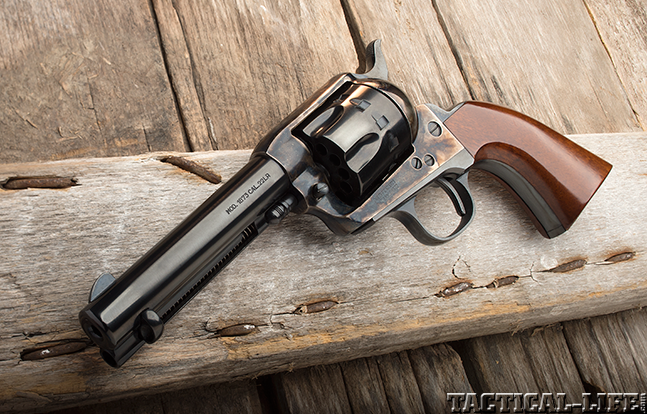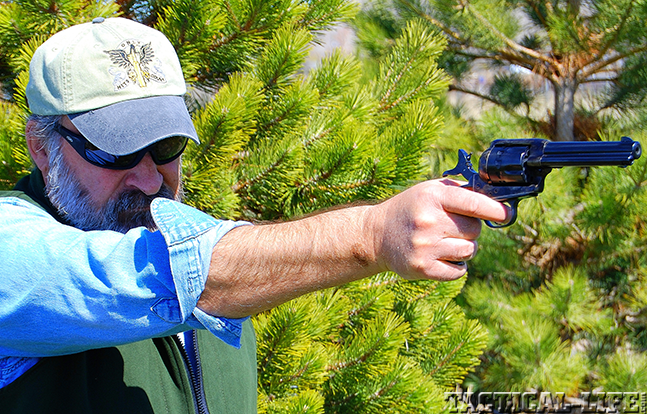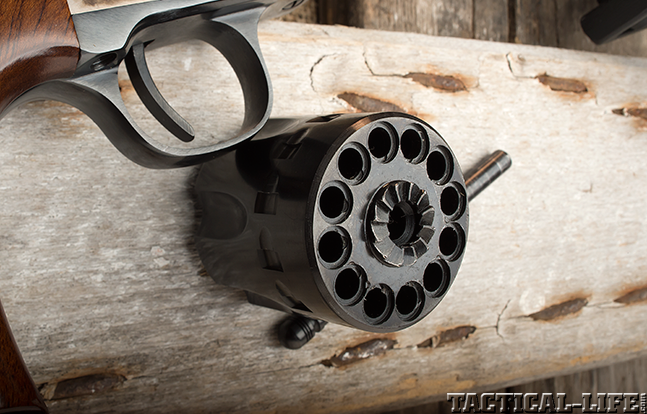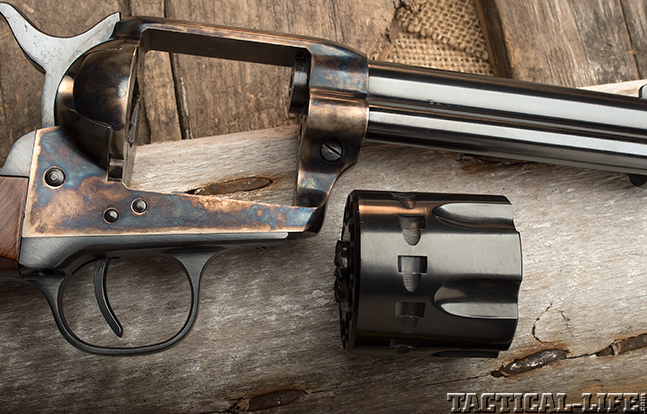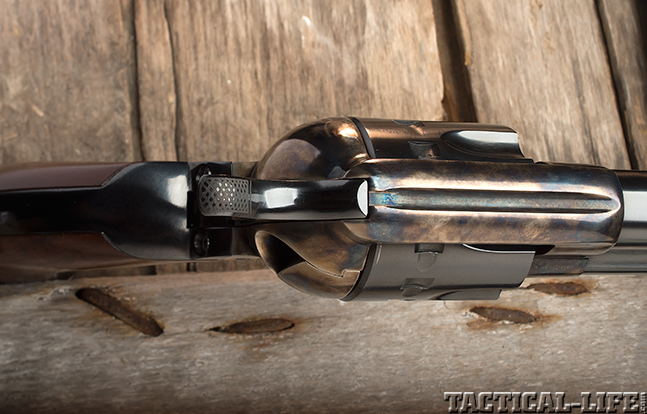Okay, let’s get it out in the open. I know what you’re thinking: cowboy gun. Well, that’s true, at least somewhat. But aside from the obvious throwback to the golden era of the cowboy heroes of old, even in these modern days of high-capacity plastic and aluminum, the iconic single-action (SA) revolver still has a place. Whether it reminds you of happier days with Hopalong and Roy, brings back a more recent childhood with your Pop and his old Colt or Ruger, or just because it’s the solid feel of blued steel and brown walnut, there’s a surprisingly large number of us who do actually prefer the lines, the heft and the uncomplicated operation of a design that simply refuses to die. This carries on with the medium- and big-bore centerfire calibers for recreation, hunting and defense, and it also holds true in the humble .22 rimfire class. Maybe even more so there, since with a rimfire version you get all the fun of history in hand without the muzzle blast, recoil and wallet drain built into the bigger centerfires.
- RELATED: Uberti Model 1873 Competition Rifle
- RELATED: Uberti 1873 Horseman Army Revolvers
Rimfire SAs can be highly enjoyable, despite their limited capacity and slow loading when compared to a more modern semi-auto .22 pistol, and they’re one of the safest learning tools for handgunners of all ages and most sizes. They allow shooters to resist the “spray and pray” tendency that’s so easy to acquire with an auto; they pretty much force you to take more time and pay more attention to basics, and after you fire a shot, you are the one who brings the next live round up in line to fire and you are the one who cocks the hammer. It’s much harder for a new shooter to create an accident
with an SA in a moment of inattention than it is with an auto that’s instantly ready for the next shot, cocked and chambered, with only a trigger finger standing in the way of an accidental discharge. It’s been said that the SA is the thinking man’s gun in terms of having to manually do what it takes to shoot one well, and while it’s still very possible to produce a major “oops” with one, it’s just simpler to operate all the way round. My firm opinion is that the SA .22 rimfire is one of the best “first guns” you can start most shooters out with, and it’s also one that can follow on with a lifetime of ear-to-ear grins after moving on to larger weapons.
Advertisement — Continue Reading Below
“As a plinker or trail gun, the Uberti Cattleman has good accuracy and keeps up with any 10-shot semi-auto in capacity, if not rate of fire.”
One of the largest downsides, admittedly, to the fixed-cylinder SA revolver is its traditional six-round capacity (five in a Colt-style gun with an empty chamber in front of the hammer while carried), single brass punch-out, and single round load-in process. For those who like to blast through several bricks of .22 rounds on a typical weekend afternoon, the SA may understandably seem a bit ponderous. But I view it as being about twice as much fun with about half as many rounds, and I’m not alone. Uberti, banking on the existence of others with similar notions, has a new version of its long-running Cattleman guns, based on the Colt Peacemaker, but now with a 12-shot cylinder instead of the time-honored six. This doubles the shooting you can do between reloads, and that’s really never a bad thing.
Advertisement — Continue Reading Below
Gun Details
Uberti’s new 12-shot Cattleman is a good-looking iteration, with a dark, well-polished bluing over most of its metalwork, excluding the color-casehardened frame and loading gate. The “colors” on the test sample actually were mostly limited to variations of lighter and darker mottled grey, but on a working gun you don’t need vivid case colors that are too pretty for use outside the house, and these gave a more “seasoned” look to areas that all fade somewhat over time with exposure to real life anyway. The hammer is fully blued, and it wears spur checkering that I think is just about ideal—neither thin enough to cause a slippage, nor aggressive enough to remove thumbprints. The metal finishes are well done on the Cattleman, as most Uberti products are—no toolmarks are visible anywhere, joints in areas like the grip frame and main frame are well mated, and the one-piece walnut grips are lightly varnished and well fitted.
In profile, the new model looks very much like other generations of Uberti Cattleman models—until you squint a little more. Then you’ll see that the front sight blade is a shade lower, and when you get back to the cylinder you’ll notice that while there are still six flutes, something doesn’t line up quite right. With the hammer either down or cocked, the position of the flutes gives the illusion of the cylinder being unlocked and between chambers. But angling the gun to look at the front of the cylinder, you’ll see that there are now two chambers between each flute instead of one, and that makes the cylinder appear unbalanced when in full lockup. Removing the cylinder shows an abnormally large number of places to insert small cartridges, along with 12 correspondingly small ratchet teeth to rotate everything with. There’s also another departure from the norm in a Colt-style sixgun—no removable cylinder bushing. If you’re really paying attention, you’ll also find small firing-pin-sized indentations milled into the recessed chambers to allow the gun to be dry-fired without damage to the pin or cylinder from an impact between the two. This is a nice touch, but dry-fire can be hard on these guns in general (regardless of maker), and I’d suggest you use either spent cases or .22 snap caps if you feel the need to click a lot.
Advertisement — Continue Reading Below
Over the years, Uberti has used a couple different approaches to meet U.S. import safety device requirements, and this model has them. One is a double-notched cylinder base pin, the other is a hammer-mounted “block.” The first has two notches milled around the forward end of the extended pin; the rearward notch is in the normal position held by the transverse base pin “latch” or button, and in that position the hammer can fall fully down. To use the pin’s “safety” notch, depress the latch button and push the base pin backwards as far as it’ll go, with the hammer on its second notch (or click), until the pin can be locked in place by the latch. That leaves it extending far enough out the back of the frame to block the hammer from falling completely, keeping the firing pin well away from any possible contact with a primer or case rim.
The second safety is a sliding block set in the hammer’s face just directly below the firing pin; this one’s automatic, and it activates itself in case of a thumb slip either during cocking or when manually lowering the hammer. If the trigger’s pulled and held back in normal use, the hammer falls unobstructed to fire a round; if the hammer slips and falls with the trigger not held to the rear, either the half-cock hammer notch will catch it or the small block will rise up to sit between the hammer and frame, again preventing contact between the firing pin and a cartridge. If this happens, just re-cock the hammer, allowing the block to reset itself, and you’re in business again.
This is probably a good spot to point out the correct etiquette for handling the hammer on a Colt-pattern SA. Once you pull the hammer back to its loading notch, pull it back all the way to full-cock and then lower it to rest. If you only pull it partially back, or to the loading notch, and then pull the trigger to ease the hammer down with your thumb from there, the cylinder locking bolt in the frame will rise prematurely and you’ll eventually get a nice turn line engraved in the bluing around the cylinder from indexing the cylinder manually to lockup.
Advertisement — Continue Reading Below
Range Time
Off the bench at 25 yards, the rimfire Cattleman easily held under 3 inches with two loads and under 2 inches with two other loads, which is more than adequate to handle an afternoon “tin can challenge” or occasional small-game chores. The gun’s a full-sized copy of the Colt Peacemaker externally, which means it’ll fit in any leather built for the Colt, but its sights don’t follow the original Colt dimensions, which is a positive. The front blade and rear notch are both wide enough to actually see, instead of narrow and claustrophobic like the older Colt’s.
Advertisement — Continue Reading Below
The trigger pull broke at just over 3 pounds with quite a bit of early grit that smoothed out markedly by the end of the test session, and I’d expect it to continue breaking itself in with use. Loading and ejection were both easy, with the Cattleman indexing its chambers perfectly on each rotational click with the loading gate cutout in the frame and the ejector rod. Velocities were respectable through the 4.75-inch barrel, with low standard deviations. If you need more speed, the model is also offered with 5.5- and 7.5-inch barrels. The only real complaint I could drum up on the gun was the elevation, which shot close to 3 inches high at the 25-yard test distance.
As a plinker or trail gun, the Uberti Cattleman has good accuracy and keeps up with any 10-shot semi-auto in capacity, if not rate of fire. Its price of $569 will buy you both tradition and performance, and it’ll put solid steel in your hand. If you already have a holster for a centerfire version, you’re already ahead of the game. I always enjoy working with a single action, and this one was no exception.
For more information, visit uberti.com or call 800-264-4962.
Advertisement — Continue Reading Below
